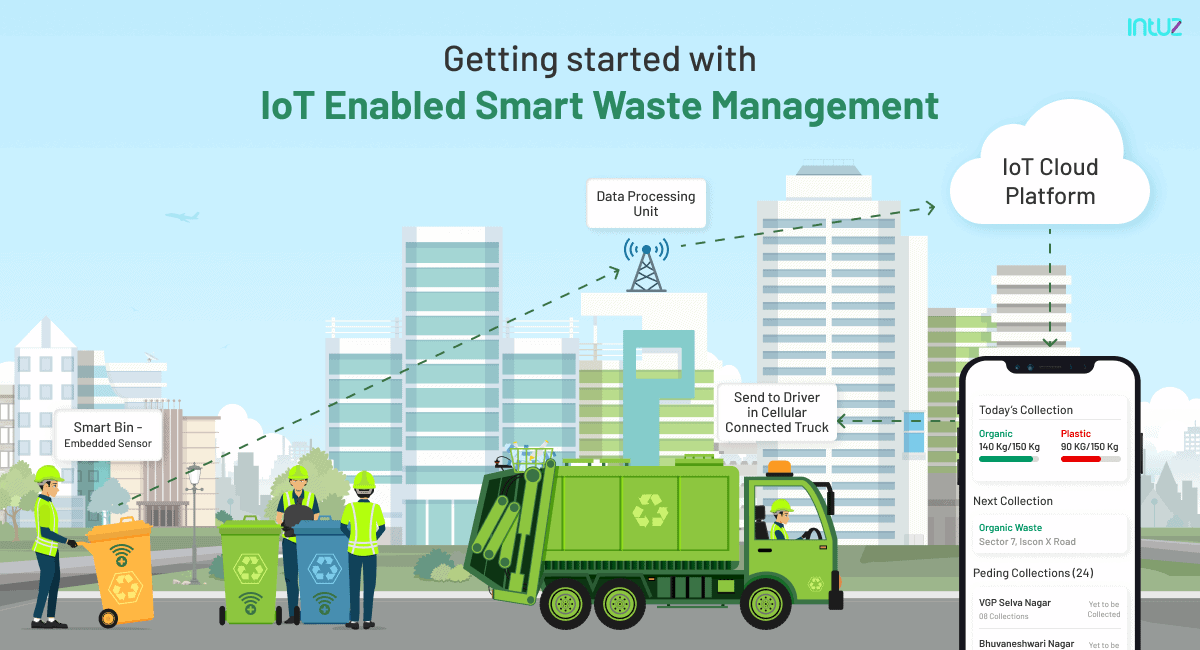Smart waste management is an important step in making waste management easier and more effective. Using technologies such as IoT, we can get closer to the goal of an environmentally-friendly waste management system in the near future. Join us as we go over the details of implementing such a system and the technologies it would require.
Waste management has become a major problem for the world due to the fast-paced consumer lifestyles of the modern age. The results of 2.01 billion tonnes of waste being produced each year have raised massive concerns for the environment. Studies done by the World Bank have shown that this waste is barely managed with at least a third of it going unnoticed on a road to greater environmental pollution. While rural regions also contribute to this waste, a majority of it comes from cities.
As a result, the waste management of cities has become one of the most researched topics of the modern era. Currently, the solution seems to be in the form of a smart waste management system that can help in reducing the amount of waste that contributes to our environmental footprint. By making the switch towards smarter waste management systems, we can help make the world a lot better than it currently is.
However, before we go over smart waste management systems, it is crucial to understand current waste management works as it will help us understand its limitations and just what is needed from a smarter system.
How the Current Waste Management System Functions
When talking about waste management, the process begins from the time an object is classified as waste till it is processed and either dumped or added back to the system. This process is actually quite ancient with primitive humans who would carry their waste deep underground. Since then, the process has indeed gotten more sophisticated with various different disposal practices and legal frameworks being put in place to accommodate the generation of waste from modernity. The following are some of the most common practices in current waste disposal systems.
- Landfill
Landfills are perhaps the most common form of waste management as they are extremely cost-effective. Usually, landfills involve a large area of land where waste can be dumped indefinitely or until it is to be processed by other methods. These are also called garbage clumps or trash sites and need to be kept in check as they are a major source of land, water, and air pollution.
- Incineration
Incineration is perhaps the easiest way to get rid of most forms of hazardous waste materials such as infectious waste, cytotoxic waste, and chemically hazardous waste from pharmaceuticals. In some cases, when the trash is burnt, the incinerator uses the released heat to generate electricity, but it also causes harmful chemicals and toxins to be released into the atmosphere, thereby polluting all the surroundings as well.
- Recycling
Recycling is one of the most eco-friendly methods of waste management where the waste materials are broken down into basic components such as metal, glass, plastic, etc. Unfortunately, this isn’t carried out as much as landfills or incineration due to feasibility and economic factors.
- Biological Processing
Most organic waste is biodegradable and is therefore useful in returning nutrients to the soil. Biological processing utilizes natural bacteria to convert organic waste matter into manure and compost matter that is used for fertilizing plants in a given region.
- Waste Collection
Waste collection isn’t a form of waste disposal but it is an integral step in the waste disposal process as a whole. In most modern cities, this is carried out by fleets of trucks that collect the waste from large trash bins.
- Energy Recovery
Various waste disposal methods can be classified as energy recovery processes that help generate usable energy in the form of heat, electricity, or fuel for vehicles. Some common processes used for this are Incineration and biofuel generation reactors.
As you can see the current processes of waste management in modern cities is carried out in a manner that creates more problems while trying to solve an existing one. Here are some of the common problems encountered during the cement waste management processes:
- Low cost-efficiency
- Health and environmental hazards
- Unreliable waste separation processes
- Recycled products have lower durability
Smart Waste Management: A New Frontier
Smart waste management is a new and innovative practice that will help overcome the disadvantages of current waste management practices thanks to innovative technology being used. It is a process that will help make all waste management practices economically and environmentally safer and more stable.
One of these innovative technologies is IoT or the Internet of Things. This technology allows smart devices to communicate with each other without any direct human interaction needed. This can help smart waste management systems function effectively and without much human supervision. Let’s take a look at some of the common technologies that can be implemented in the near future.
IoT-Enabled Smart Waste Management Solutions
- Smart Bin Sensors
Smart bin sensors can help make dumpsters a lot smarter, thereby increasing the efficiency of the waste collection process. With smart dumpsters, it will be easier for collection trucks to remotely measure the vacant capacity of each dumpster and accordingly plot the path toward their daily collection.
With such route optimization, costs during collection will be greatly reduced, and dumpsters that need priority cleanup will be a lot more likely to receive it quickly.
- Smart Fleet Management
Smart fleet management correlates with smart dumpsters and will help collection agencies to more efficiently manage their collection trucks. Using GPS and sensors to measure the current capacity of each truck in real-time, it will be possible to assess the most efficient route for the fleet if a priority request is placed by a smart dumpster.
- Data Mining
While the above processes only help improve the efficiency of the waste collection process, it is possible to also improve the effectiveness of the waste disposal methods as well. Using data mining and the data from various sensors in the waste management industries, researchers can help identify optimal solutions to the waste crisis that weren’t thought of previously.
This could be a game changer in helping clean up the environment in a manner that actually helps reduce the carbon footprint of our civilization instead of increasing it.
- Smart Recycling
Smart recycling is a great way to help incentivize recycling among the population. Waste materials such as old electronics contain the presence of precious metals such as gold, platinum, and silver. Moreover, harvesting these metals from e-waste is much easier than mining them from the ground, thereby making it more profitable and environmentally friendly.
Sensors can be used to help consumers identify the value of their waste products when sent for recycling and they can be paid for this waste in the form of reward points or a similar loyalty system.
Essential Features To Ensure
Some essential features that must be included in a smart waste management system include:
- Remote Monitoring
- Priority Alerts
- Data Collection Sensors
- Low-Energy Communication
- Low Learning Curve
- Support for Existing Technologies
- Easy Upgrades and Expansion
- Cybersecurity and Data Protection
The above features will help make this endeavour more profitable for waste management agencies and thereby make them more likely to implement it in the near future.
Technologies to Implement
Some essential technologies that will help make the IoT-enabled smart waste management systems work seamlessly are:
- RFID Chips
These chips will help with the easy classification and separation of waste types when needed during the collection and disposal processes.
- GPS
GPS will help fleet managers optimize their routes in an efficient manner and reduce fuel and resource consumption during collection.
- IoT Sensors
IoT-powered sensors will help in the remote monitoring of various variables involved in waste management and they will also collect the data needed for further research in the field.
- Data Processing Cloud Platforms
Data processing cloud platforms will help reduce the expense of implementing processing capabilities on waste management agencies and also help protect the integrity of their data.
Final Thoughts
While smart waste management may seem like a far-fetched idea for now, it is one that will help revolutionize the way we care for our environment. With each advancement in the right direction, we can construct a waste management system that can keep up with the needs of the modern world without compromising on the environment’s sustainability.
Patrick R, A techno-commercial leader heading Intuz as Director of Growth With over 12 years of experience in the field of Information Technology. His experience and expertise will entice developers and business entrepreneurs with rich content on latest technology stack. Visit for more information: https://www.intuz.com/


























































































































































































